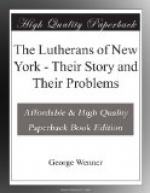But while this movement, which Julius Stahl felicitously termed the Conservative Reformation, was going on, there was also a radical Reformation which repudiated the idea of a visible church. The Romanists, in their confutation of the Augustana, called attention to this view, and wrongfully charged the Lutherans with holding it. In controverting this position, the Romanists very properly quoted the parable of the tares and the parable of the net with all kinds of fishes. The Apologia replied by showing that the 8th Article of the Augustana had repudiated this position, and that bad men and hypocrites were not excluded ab externa societate.
Thus the Romanists regard the Church as essentially visible, the Reformed, as essentially invisible, while Lutherans hold that she is both. The invisible Church is contained within the visible just as the soul is contained within the body. The Church is not merely a congregation of believers, but also an institution for the promotion of the Kingdom of God.
In their controversy with Rome Lutherans held that the Church did not exist merely in participation of external rites, but chiefly in the possession of the inward life, the heavenly gifts. As yet the kingdom of Christ is not revealed, and the visible Church is a corpus mixtum. Thus the Apologia distinguishes clearly between the ecclesia proprie et large dicta (church in the proper and church in the wider sense of the term).
Nevertheless this Kingdom of Christ has a visible existence. “We are not dreaming of a Platonic commonwealth,” says the Apologia, “for it has external marks, the preaching of the pure Gospel and the administration of the sacraments.” And this Church is the “pillar and ground of the truth,” for she is built upon the true foundation, Christ, and upon this foundation Christians are built up.
Subsequently, in his Loci, Melanchthon developed still further the idea of the Church as an institutum. This may have been because of the fanatics, or it may have been because of his entire disposition as a teacher and pedagogue. Followed as he was in support of his views by the dogmaticians, the Lutheran Church acquired that distinctive character which has marked her history as an educating and training force. This position is still further explained from the fact that the Lutherans, unlike the Reformed, were placed in charge of nations and peoples, and had to be responsible for their Christian guidance and training. As a national church, her relations to the people were different from those of the Reformed, who, on the continent, existed mainly in smaller communities and congregations where it was comparatively easy to enforce church discipline.
In this relation the Church is not only the product, but also the organ of the Holy Ghost. It is her duty to nourish the life of its members (parturit et alit), and to spread the blessings of the Church to others. According to the Large Catechism, she is the spiritual mother of the faithful. Her pedagogic duty is pointed out. (See Rohnert, Dogmatik, pp. 508 and 487.)




